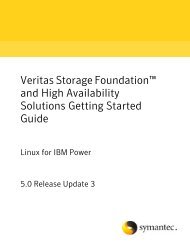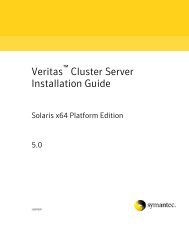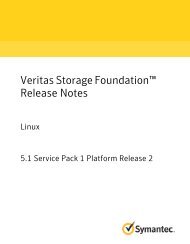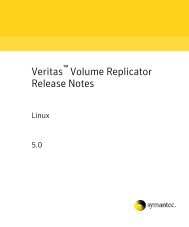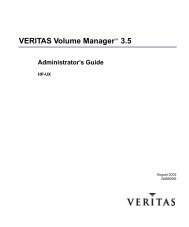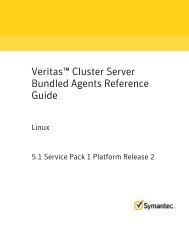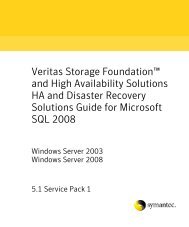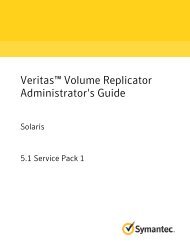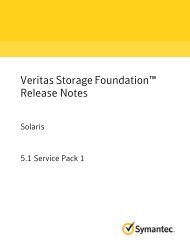Veritas Storage Foundation™ and High Availability Solutions ...
Veritas Storage Foundation™ and High Availability Solutions ...
Veritas Storage Foundation™ and High Availability Solutions ...
Create successful ePaper yourself
Turn your PDF publications into a flip-book with our unique Google optimized e-Paper software.
128<strong>Veritas</strong> Cluster Server: Configuring Oracle VM Server for SPARC for high availabilityOracle VM Server for SPARC guest domain migration in VCS environmentThe Oracle VM Server for SPARC 2.1 introduces live migration, which providesperformance improvements that enable an active domain to migrate while itcontinues to run.In addition to live migration, you can migrate bound or inactive domains. Thismigration is a cold migration.You can use domain migration to perform tasks such as the following:■■Balancing the load between systemsOverview of a warm migrationPerforming hardware maintenance while a guest domain continues to runThe Logical Domains Manager on the source system accepts the request to migratea domain <strong>and</strong> establishes a secure network connection with the Logical DomainsManager running on the target system. Once this connection has been established,the migration occurs.The migration operation occurs in the following phases:Phase 1Phase 2Phase 3Phase 4After connecting with the Logical Domains Manager running in the targethost, information about the source system <strong>and</strong> domain are transferred tothe target host. The Logical Domains Manager on the target host uses thisinformation to perform a series of checks to determine whether a migrationis possible. The checks differ depending on the state of the source domain.For example, if the source domain is active the Logical Domains Mangerperforms a different set of checks than if the domain is bound or inactive.When all checks in Phase 1 have passed, the source <strong>and</strong> target systemsprepare for the migration. The Logical Domains Manager on the sourcesuspends <strong>and</strong> the source domain. On the target system, the Logical DomainsManager creates a domain to receive the source domain.For an active domain, the next phase is to transfer all the runtime stateinformation for the domain to the target. The Logical Domains Managerretrieves this information from the hypervisor. On the target, the LogicalDomains Manager installs the state information in the hypervisor.H<strong>and</strong>off—after all state information is transferred, the h<strong>and</strong>off occurs whenthe target domain resumes execution (if the source was active). The LogicalDomain Manager on the source destroys the source domain. From this pointon, the target domain is the sole version of the domain running.



